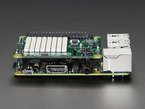OTTStreamingVideo.net designed, built the hardware, and wrote C++ and Python software for an autonomous 1/10th scale radio control car, which was the first vehicle that runs on the Future Airborne Capability Environment (FACE) open systems architecture, was demonstrated at the December 6-9, 2016, industry and government meeting.
OTTStreamingVideo.net designed, built the hardware, and wrote C++ and Python software for a 1/5th scale Piper Cub model aircraft (90 inch wingspan), which was the first airborne vehicle that incorporated the Basic Avionics Lightweight Source Archetype (BALSA) software architecture that is part of the Future Airborne Capability Environment (FACE) open systems architecture. This autonomous model aircraft was demonstrated at the June 6-8, 2017, FACE Consortium Members Meeting at the AMA field at Whitter Narrows Recreation Area in Rosemead, California.
This 1/5 scale airborne vehicle featured a Raspberry Pi 3 Linux computer running the Basic Avionics Lightweight Source Archetype (BALSA) C++ code which transmitted real-time navigation data to a second Raspberry Pi 3 Linux computer performing automatic navigation and servo control of flight control surfaces in Python (download PDF from http://oaevents.goprecise.com/wp-content/uploads/2017/11/Infinite-Dimensions-FACE-Vehicle-Control-Navigation-17-Oct-2017.pdf).
On August 23, 2017, the U.S. Army Acquisition, Logistics, and Technology (AL&T) magazine published an article and photograph stating:
- The final team built on their integration activity from the pilot BITS event by controlling a fixed-wing aircraft instead of a radio-controlled car (two OTTStreamingVideo.net team members are pictured).
On July 24, 2018, Fox News published an article stating:
- The UH-60V digital cockpit meets the military’s Future Airborne Capability Environment (FACE) standard. This means that the Army can rapidly insert and integrate different off-the-shelf hardware and software to further upgrade the helicopter.
The Raspberry Pi 3 Model B can be used as an embedded Linux controller with GPS, magnetometer, and gyro, vision, airspeed, ultrasonic range finder for collision avoidance and distance above ground, and other sensors. Analog to Digital converters can be employed to interface with virtually all analog sensors.
The Ultimate GPS Breakout has a serial interface that runs up to 115,200 baud with standard NMEA GPS sentence data.
The Sense HAT attaches to the Raspberry Pi’s 40 pin connector as a “hat”, which make the size of the two devices only slighter larger than the Raspberry Pi itself.
The Sense Hat has an 8×8 RGB LED matrix, a five-button joystick, and includes the following sensors:
- Gyroscope
- Accelerometer
- Magnetometer
- Temperature
- Barometric pressure
- Humidity
For low to moderate performance requirements (e.g. 1-10 updates/second), Python can be effectively utilized for autonomous navigation.
For high performance requirements (e.g. 100-1,000 updates/second), C or C++ can be used for autonomous navigation.
The small size and weight of the Raspberry Pi and sensors allow for use in scale models for engineering development.
